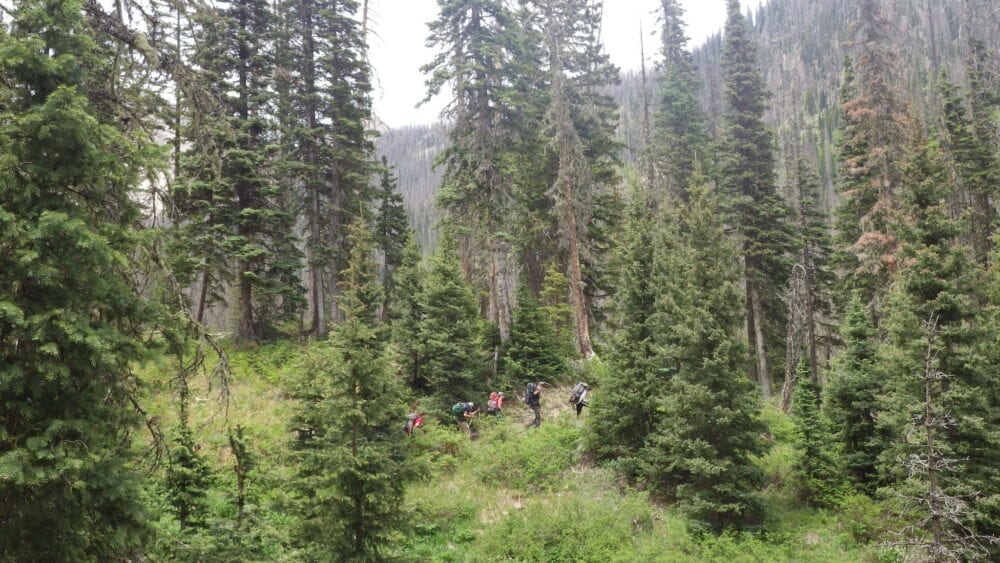
By Sanna Sevanto
Springtime in aspen and mixed-conifer forests brings many shades of green. On south-facing slopes, the dark shades of firs and spruces are contrasted by the bright, almost translucent green of the new leaves of aspens, while aspens on north facing slopes or in shady canyons might still have no leaves.
Firs and spruces, and also pines and junipers, belong to a group of plants called evergreen conifers or gymnosperms. Evergreen refers to the fact that they keep their leaves all year round. Conifer means that they carry their seeds in cones, and gymnosperm means that their seeds are bare, not enclosed in an ovary.
Aspens on the other hand, are deciduous angiosperms. Deciduous means that they drop their leaves every year, and angiosperm means that their seeds are covered. However, whether the seeds are covered or not is less relevant for the plant’s lifestyle than other differences that stem from these groupings.
All plants make their food in a process called photosynthesis where they take carbon dioxide from the air, and use sunlight and some water to produce sugars. This is the process that makes all the sugar we eat. To get the water up to the leaves, trees have developed a special tissue that we call wood. The young wood in the outer rings of the trees, below the bark, is called xylem, or sapwood, and can conduct water. The particular structure of this tissue determines how easy it is for the tree to get water to its leaves, and how fast it can grow.
Gymnosperms like spruces, pines, and firs, developed earlier in the evolutionary process than angiosperms like aspens. Gymnosperms existed for hundreds of millions of years before the dinosaurs, while angiosperms developed only just before dinosaurs went extinct. The wood of gymnosperms contains smaller tubes than the wood of angiosperms. Therefore, it is harder for gymnosperms to transport water from the soil to their leaves.

Gymnosperms also make sugars in their leaves at a slower rate than angiosperms, and consequently grow more slowly. When growing together with angiosperms, gymnosperms compensate for the slow growth rate by staying evergreen so that they can start photosynthesis as soon as air temperature rises above freezing even in the winter. They also can do photosynthesis at lower light levels than angiosperms. Therefore, you can see small spruce or fir saplings growing shaded under large trees, and slowly outgrowing aspens that need a lot of light.
Aspens, on the other hand, compete by growing tall very fast. This is made possible by the large water tubes in their wood, and the high photosynthesis rate their leaves can produce. But the fast growth rate comes with a cost. Their wood and leaf tissues are not as strong and sturdy as the wood and leaves of spruces and firs. Therefore, aspens don’t live as long as spruces and firs, and they have to drop their leaves every winter. The leaves wear out during the summer so much that they would not be functional next summer even if the plant tried to keep them. In the fall, aspens break down and pull the precious chlorophyll (the material that makes leaves green and is responsible for photosynthesis) back to their bark and roots for storage. As a result, the leaves turn yellow. In the spring, aspens use the stored chlorophyll components and sugars stored in their bark and roots to make the new leaves.
Because of the fast growth rate, aspens are one of the first trees to cover new openings in the forest, for example after a forest fire. Most of the aspen groves you see on the mountains cover old fire scars.
Comparing the lifestyle of aspens and the conifers in our forests, aspens are like mice of the plant world: they grow and reproduce fast, cover new territory quickly, but also die quickly. Spruces and firs are like turtles, who live much longer, but move and grow slowly. This is all in relative terms of course! A typical age of dying aspen stems is over 100 years, while spruces and firs can easily live several hundred years.
But all is not quite as it seems. The aspen stems that you see in a grove are actually branches of the same tree growing from a very long-lived root system. It is said that Pando, an aspen grove in Utah, is among the oldest living organisms on Earth. This aspen tree covers an area of 106 acres and some estimates suggest it is over 80,000 years old.
